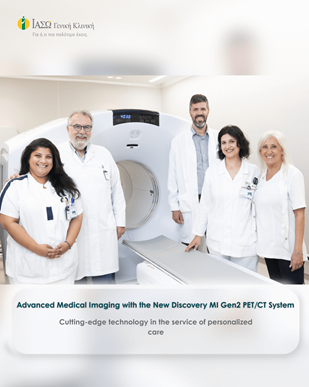
FAQ
Oncology Center
Call center
210 618 4000 -
About Radiation Therapy
- Radiation therapy does not cause pain.
- External radiation therapy does not make you a radiation emitter.
- Therapies are usually scheduled on a daily basis, except Saturdays, Sundays and bank holidays.
- Your daily stay in the center is about 30min. The treatment duration is approximately 10 minutes.
- It is important that you follow a balanced diet during radiotherapy. In addition, you should engage in intense activity.
- Your skin in the body area being irradiated may be irritated.
- The side effects of radiation therapy are usually temporary and vary depending on the area of the body being treated.
- Patients undergoing radiation therapy are given detailed instructions on daily care prior to initiation of treatment.
-
What is radiation therapy?
Radiation therapy uses a high-energy beam (particle or electromagnetic), and is one of the predominant "weapons" in the fight against neoplasmatic and non-neoplasmatic diseases.
Radiation is emitted by special machines, linear accelerators, and is directed to the area where the disease is detected. Radiation is administered in many "fractions", usually one fraction per day, and is completed in 3-6 weeks. -
How does radiation therapy work?
Healthy cells have a different behavior in radiation administered at high doses than neoplasmatic cells.
Irradiation of healthy cells may temporarily alter their function, leading to side effects. Through biological mechanisms, however, most of the cells recover, i.e. they repair the damage.
On the contrary, neoplasmatic cells are more susceptible to radiation exposure (due to their faster reproduction and growth rates), resulting in their destruction (necrosis) or growth and spread limitation. This makes radiation therapy a powerful "weapon" in dealing with many types of neoplasias. -
What are the side effects of the treatment?
The effect of radiation on healthy cells may cause the onset of side effects, which may even occur during the radiation therapy session. Nevertheless, they are usually temporary, and most of them are well considered in advance and, hence, effectively treated. -
What is the goal of radiotherapy?
The goal of radiotherapy is the destruction of neoplasmatic cells with the least possible burden on healthy cells - tissues. -
How is radiation therapy applied?
Radiation therapy is applied locally on the area where the tumor is detected, and can be used as monotherapy or combined with other treatments:
a. Chemotherapy - Administration of cancer drugs before, during or after radiation therapy. It depends on the location and type of neoplasia.
b. Surgery - Surgical removal of neoplasias. In some cases, radiation therapy precedes surgery to shrink the tumor, making it more easily accessible. In other cases, radiation therapy is administered after the surgery to irradiate suspect areas possibly spreading the disease. -
How is radiation therapy administered?
There are two main types of radiotherapy: external and brachytherapy. Many patients undergo both types, depending on the treatment site and their medical history.
In external radiation therapy, radiation beams are directed to the area of the disease, including a small margin around it.
When applying brachytherapy, a radioactive source (usually Iridium-192) is placed inside the body by means of suitable applicators (thin plastic catheters). Radiation is emitted locally in the area of the disease for as long as the radioactive source remains in the patient's body. -
What is treatment planning?
Through this process, all information about tumor location, size and shape is obtained. For this reason, a CT-scan of the area is performed and, according to the acquired images, treatment is determined. -
What is a treatment plan?
Medical physicists from the Department of Medical Physics prepare the treatment plan, and determine the way the treatment will be administered, choosing the geometry of the radiation fields, allowing for the area demarcated by the physician to receive the maximum dose, while the surrounding healthy tissues receive the minimum dose possible. Treatment plans are verified by machine measurements or independent calculations prior to initiation of treatment. -
What is the pre-treatment procedure?
After examining your medical history, the physician proceeds to planning the treatment. The process starts with the so-called simulation. Simulation takes about 30 minutes.
You will be asked to lie down on the bed of a specially configured radiology machine - simulator - that simulates all movements of the linear accelerator.
The radiation oncologist, taking care to reduce the burden on healthy tissues to a minimum, determines the optimal radiation entry point (irradiation field) in the area to be treated. Depending on the area where the disease is detected, more than one field may be used.
Simulation may also be performed by CT-scanning combined with other imaging methods (MRI, PET, etc). The images obtained are then used by the radiation oncologist to determine the area where the disease is found as well as the surrounding healthy tissues - organs.
To reduce any involuntary movement of the patient during treatment, special immobilization equipment - masks (for treatments of brain, head, neck, etc) are often used.
In addition, radiation field entry points are permanently marked with India ink (small spots) on the patient's skin to ensure repeated placement in the correct site.
Next, the medical physicist and the physician work closely to plan the applicable treatment. The physician prescribes the total radiation dose to be administered and number of fractions required (number of visits to the center). The medical physicist determines the optimal geometry of the irradiation fields individually for every patient, and calculates the dose that each field delivers in the area the disease is found (treatment plan). Special care is taken during treatment planning to protect sensitive organs and limit the possibility of any side effects occurring.
Following the designing of the treatment plan, "verification" simulation of the treatment plan is performed prior to its application in daily clinical practice. The geometric data of the plan are compared with the corresponding data obtained from the "verification" simulation and, where appropriate, the necessary corrections are made.
When a treatment plan receives the final approval by the attending physician, the dedicated computer system (TPS – Treatment planning system) sends the treatment plan electronically to the department’s Patient Management System (Mosaiq), which ensures the correct administration of the treatment. -
What is the procedure during treatment?
Upon your arrival at the center, you must present yourself to the secretariat. They will inform you of the exact time of your treatment and the linear accelerator your treatment session will be performed with (the center’s corridors are marked with colors - each linear accelerator corresponds to a different color). Then, you will be taken to the treatment room where you will receive your daily treatment (linear accelerator room).
You may be asked to wear a hospital gown before you enter the treatment room.
In the room, the technician, using personalized immobilizing systems and taking into account the marks on your skin, will place you in the correct treatment position. Session times vary from 10-20 minutes. Most of the time is spent on your correct positioning. The beam delivers radiation for 1-2 minutes.
During treatment, you should remain still so as to avoid accidental delivery of radiation to non-target areas. You do not have to hold your breath; breathe normally and do not feel tense. Following your placement in the right position, the technician and the rest of the staff will leave the room.
The technician of the machine watches you from a closed-circuit television with two-way audio communication, and he can interrupt the delivery of radiation at any time, in case you do not feel well.
During some of your sessions you will undergo radiographic screening to ensure your correct position -images (X-ray or CT-scanning) are obtained when in the machine, prior to treatment. -
What are the specialties involved in implementing the treatment?
Radiation Oncologist:(radiotherapist = technologist). This physician specializes in radiation oncology and knows how to use radiation to treat the disease. He works closely with physicians in other specialties (radiologists, nuclear doctors, oncologists, etc.) to get as complete a picture of the disease as possible. Your physician is responsible for your treatment. He decides on the total number of fractions and the total dose that should be delivered in the affected area as well as the tolerated dose in the surrounding healthy tissues. Your physician monitors you almost daily and works closely with the whole team to provide you the best treatment.
Medical Physicist: He is responsible for the dosimetry of radiotherapy radiation devices and the safe administration of the desired radiation dose for each patient.
At regular intervals, he applies radiotherapy quality control protocols and, together with all members of the center's team, ensures that the treatment is accurate and repeatable in all its steps.
He collaborates with the Radiation Oncologist to determine the patient's treatment and, on a specialized computer system (Treatment Planning System), he performs the treatment plan, arranges the radiation beams of the radiotherapy machine to focus on the malignant tumor, in order to avoid any neighboring tissues to the extent possible.
Also, during treatment with radioactive materials introduced or implanted in the patient, i.e. brachytherapy, the Radiation Physicist is responsible for the safe handling of the radioactive sources and their dosimetry.
Technologist: He is responsible, in collaboration with the attending physician and the medical physicist, to place the patient in the correct position for treatment and also for the administration of the treatment.
He performs regular X-rays or CT-scans of the irradiated area to check on both the position of the patient and on any changes in tumor size and shape. In any case, he informs the attending physician. -
3D Conformal Radiotherapy
3D Conformal Radiotherapy refers to the technique of forming high dose areas as the "template" of the three-dimensional form of a tumor and, at the same time, it prevents irradiation of large parts of normal tissues and organs, resulting in less toxicity and fewer side effects. -
Intensity Modulated Radiotherapy
The Intensity Modulated Radiotherapy (IMRT) is a sophisticated 3D CRT form which, by modulating radiation intensity, allows a greater degree of compliance of the dose distribution to the three-dimensional shape of the tumor, while minimizing the burden on surrounding healthy tissues. In this way, it is possible to increase the dose to the target tumor and increase the likelihood of healing. -
Volumetric Modulated Arc Therapy
The Volumetric Modulated Arc Therapy (VMAT) is essentially a rotational IMRT radiotherapy technique. As the linear accelerator rotates around the patient, it modulates the intensity of the radiation it emits. As a result, treatment takes less time. It is a routine procedure in our center. -
Flattening Filter Free radiotherapy beams
Flattening Filter Free radiotherapy beams are given at times much shorter than conventional, maximizing the effectiveness of the treatment. Thus, the likelihood of involuntary movement of the patient and internal movement of the organs is limited. -
Image Guided Radiation Therapy
Imaging Guided Radiation Therapy (IGRT) is the procedure in which the patient's position on the linear accelerator bed is checked on and, if necessary, corrected before treatment is applied. It is performed by Cone-beam Computed Tomography (CBCT) via a suitable imaging system adapted to the linear accelerator or X-ray machine.
IGRT allows:- Real-time monitoring of the patient's irradiated area.
- "Elimination "of positioning errors (precision, accuracy)
- Adaptation of treatment to the target tumor according to the daily normal organ movement and tumor size.
- Dose escalation to the target tumor with simultaneous protection of healthy tissues and, thus, optimal therapeutic effect.
-
Adaptive Radiotherapy
During treatment, the size and/or shape of the tumor may be altered, and the patient may also lose a lot of weight. In such cases, the geometric data of the treatment plan do not match that of the patient. For this reason, and only after the attending physician’s decision, a new treatment plan is designed from the beginning (new CT-scanning, new immobilization mask, new plan). -
What is Brachyterapy?
Brachytherapy is the oldest, yet less known radiotherapy method. In brachytherapy, radioactive sources are distributed intracavitarily and interstitialy or contact the target tumor to irradiate it at high doses, and minimize the burden on the adjacent healthy tissues-organs.
In particular, High Rate Dose Brachytherapy (HDR) uses high-activity sources (Ir-192) allowing the dose to be administered in the shortest amount of time (lasts only a few minutes) in the best possible way. -
How often will I receive radiotherapy and for how long?
In most neoplasia cases, radiotherapy requires daily visits (except Saturdays, Sundays and bank holidays) for a few weeks (2-8).
In this way, healthy tissues that are inevitably irradiated, having better repair mechanisms than neoplasmatic cells, can correct (even between two consecutive sessions) damages caused by the treatment.
It is important, however, that there should be no unnecessary interruption of the treatments, as this will result in their non-effective action.
Information









